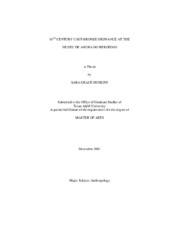16th Century Cast-Bronze Ordnance at the Museu de Angra do Heroismo
Abstract
Within the collections of the Museu de Angra do Heroismo (Terceira Island, Azores, Portugal) are nine cast bronze guns from the 16th century. Most were raised from the seafloor between the 1960s and 1990s, but this study comprises the first in-depth research into their design and manufacture. The importance of this kind of study lies in the fact that ordnance is commonly found on shipwrecks of this time. A greater knowledge of guns will help provide information about the ships from which they came.
Careful documentation and study of the Museu de Angra cannon will add greatly to their value as museum exhibits, by allowing museum patrons to better understand where the guns came from, how they were cast, and why they were important. This documentation adds to our knowledge of Western European gunfounding technology during the sixteenth century, as four different countries commissioned the guns: Portugal, Spain, France, and England. With detailed documentation and publication, the Museu de Angra bronze guns can be added to the bibliography of ordnance of this period, which will aid future researchers who encounter similar pieces.
The Museu de Angra bronze guns, as symbols of the military and naval power of the countries that commissioned them, were sent aboard ships, into the field, and mounted on fortress walls. Bronze guns of this time period are particularly important, as bronze was an expensive commodity, and the demand for ordnance was increasing rapidly. Countries developed more effective ways to make use of iron for the founding of guns, and the use of bronze became more symbolic of wealth. The information that each gun contains includes both the cutting-edge military technology of the time and the artistic statement of the founder. Some of the finest metalwork of the period was displayed in cast bronze guns, and due to the founding techniques, no two are the same, making each an important piece of history.
Citation
Hoskins, Sara Grace (2003). 16th Century Cast-Bronze Ordnance at the Museu de Angra do Heroismo. Master's thesis, Texas A&M University. Texas A&M University. Available electronically from https : / /hdl .handle .net /1969 .1 /556.


